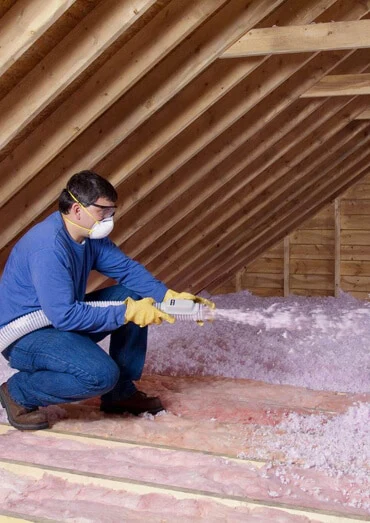Why Attic Insulation DFW is Essential for Energy Performance in Dallas-Fort Worth
Why Attic Insulation DFW is Essential for Energy Performance in Dallas-Fort Worth
Blog Article
Discover the Different Kinds of Attic Insulation and Their Unique Advantages for Your Home's Power Effectiveness

Fiberglass Insulation
Fiberglass insulation is among the most typically made use of materials for attic insulation because of its excellent thermal efficiency and cost-effectiveness. Composed of little glass fibers, this material properly traps air, creating a shielding obstacle that helps keep consistent interior temperatures. Its high R-value per inch makes it specifically reliable at withstanding warmth transfer, which is crucial for energy preservation in homes.
Setup of fiberglass insulation is reasonably straightforward, typically available in batts or loose-fill types, suiting various attic configurations. In addition, it is non-combustible and resistant to wetness, reducing the risk of mold and mildew development. This sturdiness adds to its durability, making fiberglass a practical long-lasting investment for house owners.
In addition, fiberglass insulation is typically produced from recycled products, which improves its eco-friendliness. The material can likewise add to soundproofing, reducing sound transfer between areas. While it is important to use safety gear during installation to stay clear of irritability from the fibers, the overall benefits of fiberglass insulation, consisting of power cost savings and environmental considerations, make it a popular choice for enhancing attic performance and promoting a comfortable living environment.
Spray Foam Insulation
Spray foam insulation is a very reliable choice for attic insulation, understood for its exceptional air sealing and thermal efficiency. This cutting-edge insulation material is made up of a combination of isocyanate and polyol material, which, when incorporated, broadens quickly to fill spaces and cavities in the attic room room. Its capacity to abide by various surfaces makes sure a continual obstacle against air leaks, considerably decreasing heat loss during colder months and warmth gain during warmer periods.
One of the essential benefits of spray foam insulation is its high R-value per inch, which indicates it offers excellent thermal resistance in a reasonably slim application. This is particularly useful in attics where area is typically limited. Additionally, spray foam can help decrease wetness buildup, minimizing the danger of mold and mildew and mildew development, which can be detrimental to both the framework and indoor air top quality.
While the first cost of spray foam insulation may be more than typical choices, its lasting energy cost savings, paired with enhanced comfort and boosted home value, make it a rewarding financial investment for house owners seeking enhanced power performance. Attic Insulation DFW. Generally, spray foam insulation sticks out as a reliable remedy for maximizing attic insulation
Cellulose Insulation

Cellulose insulation is a popular selection for attic room insulation, largely made up of recycled paper products treated with fire resistants. This ecologically friendly alternative is understood for its excellent thermal performance, effectively lowering warm transfer in both summer and cold weather. The thick structure of cellulose enables it to fill up spaces and voids in attic areas, giving a seamless barrier versus air leakages.
One of the substantial benefits of cellulose insulation is its ability to withstand mold and bugs, owing to the fire resistant therapies used during manufacturing. In addition, it boasts a high R-value per inch, which equates right into exceptional energy performance. Property owners can anticipate reduced cooling and heating costs as a result of improved insulation.
Installment is generally achieved via blowing loose cellulose into the wanted area, permitting for a efficient and fast procedure. This approach also lessens disturbance to the existing structure. Furthermore, cellulose insulation has a fairly reduced ecological effect, as its production process uses recycled materials, adding to sustainable building methods.
Rock Wool Insulation
Among the various options for attic insulation, rock wool, likewise understood as mineral wool, sticks out due to its remarkable thermal and acoustic performance. Made from all-natural or recycled products, rock wool is created by melting rock and spinning it into fibers, leading to a product that provides superb insulation properties.
One of the significant benefits of rock woollen insulation is its high R-value, which suggests its efficiency in withstanding heat flow. This characteristic not only enhances energy performance but additionally adds to preserving a comfy interior temperature level year-round. Furthermore, rock wool is naturally fireproof, making it a more secure choice for homes as it can endure high temperatures without melting or releasing harmful fumes.
Additionally, rock wool insulation masters soundproofing capabilities, effectively reducing sound transmission in between spaces and from outdoors sources. This makes it an optimal choice for property owners seeking a serene living environment. In addition, rock wool is moisture-resistant, aiding to avoid mold development and maintaining the structural honesty of the attic room. Overall, rock woollen insulation provides an extensive solution for improving power effectiveness, safety and security, and comfort in household setups.
Radiant Obstacle Insulation
Glowing barrier insulation acts as a reliable remedy for reducing warmth transfer in attic rooms, particularly in warmer environments. This kind of insulation works by mirroring induction heat far from living rooms, thus decreasing the quantity of heat that enters a home during heat - Attic Insulation DFW. Normally made up of a very reflective product, such as light weight aluminum foil, radiant barriers are set up in attics, facing the roof covering, where they can obstruct inbound warmth from the sunlight
The primary advantage of radiant barrier insulation is its capability to lower cooling expenses. By showing heat rather than absorbing it, radiant obstacles can aid maintain a much more secure interior temperature, minimizing the workload on cooling systems. This effectiveness translates into reduced energy expenses and raised convenience for home owners.
Along with energy financial savings, glowing obstacles can likewise add to boosted interior air top quality. By minimizing heat accumulation, they help decrease moisture degrees, which can protect against mold and click mildew growth and you can try here enhance general air flow. When installed correctly, glowing barrier insulation can be an indispensable addition to any energy-efficient home, making it a worthwhile factor to consider for home owners wanting to boost their attic room insulation technique.
Verdict
In verdict, recognizing the different types of attic room insulation-- fiberglass, spray foam, cellulose, rock woollen, and glowing barriers-- makes it possible for house owners to make educated choices pertaining to energy performance. Each insulation type provides distinct benefits, such as exceptional thermal resistance, dampness management, and sound attenuation. By selecting the proper insulation material, considerable decreases in energy expenses can be accomplished, in addition to enhancements in interior convenience. Ultimately, the ideal choice adds to an extra lasting living setting and promotes general power conservation.

In conclusion, understanding the different kinds of attic room view insulation-- fiberglass, spray foam, cellulose, rock wool, and radiant obstacles-- allows homeowners to make enlightened decisions regarding power efficiency.
Report this page